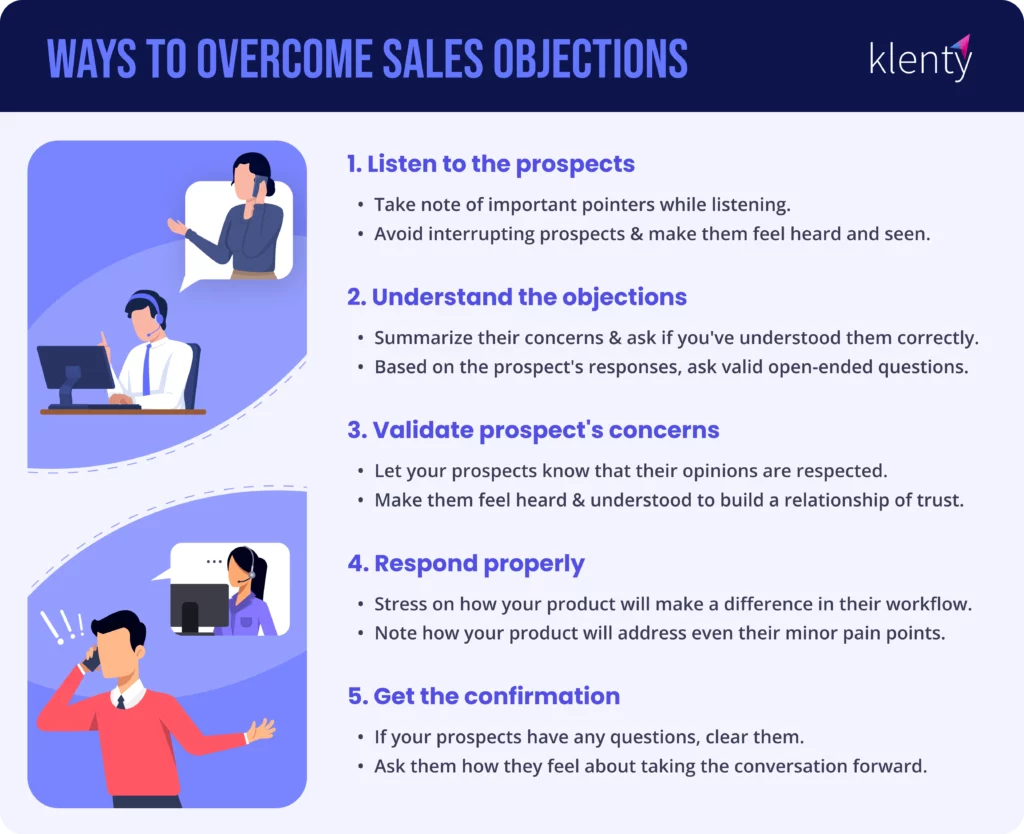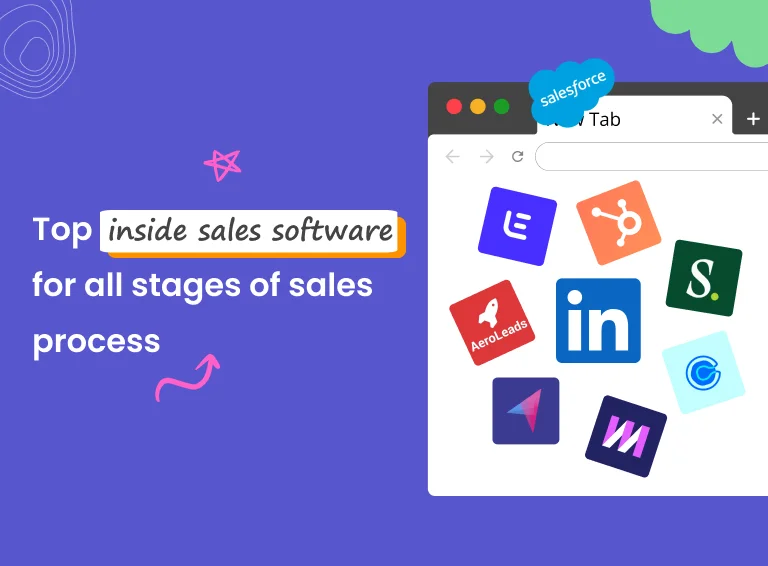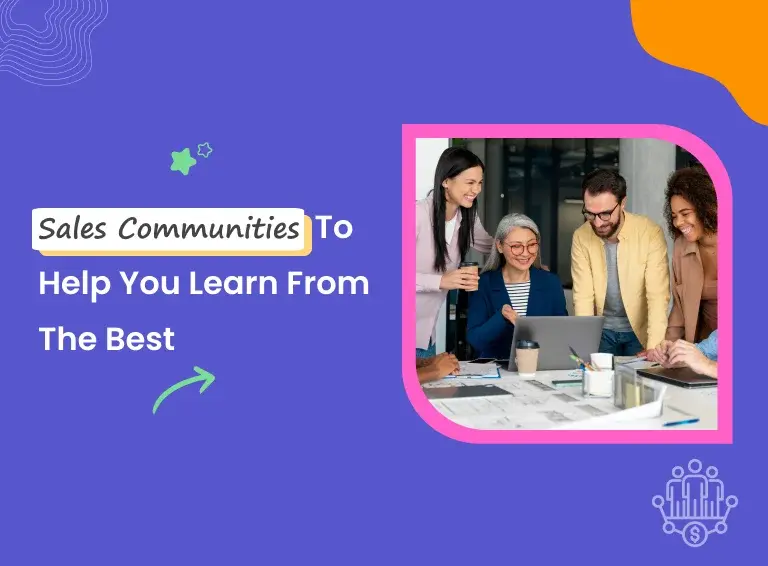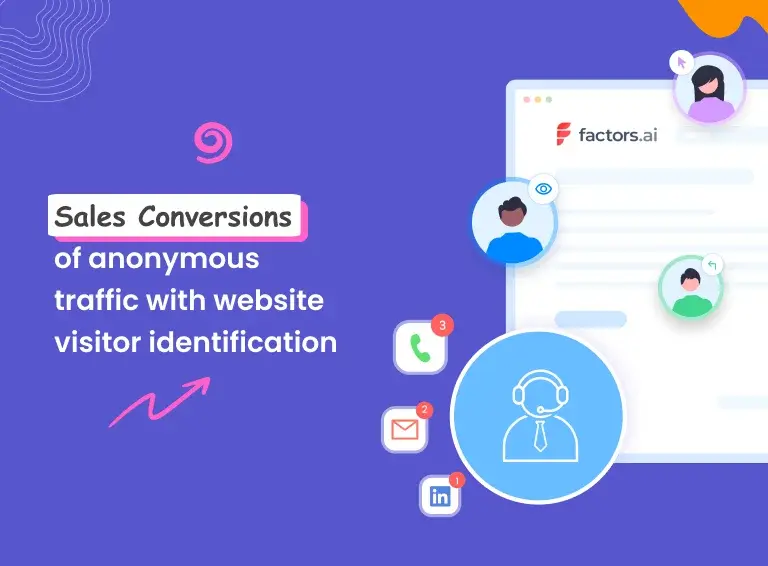“Sure, sounds good, let’s do this!”
Wouldn’t it be great if prospects would respond with this during a sales call? But alas, reality sings a different tune.
As a sales rep, you’re aware of the truth that prospects are rarely thrilled to hear you out. They will interject your pitch with a big red light called objections. These could be anything ranging from a “I don’t see how it can benefit us” to “We like your solution, but our budget doesn’t allow for it.”
So, the only way for you to convince prospects and book meetings with them is to successfully handle whatever objections they throw your way.
Here, we discuss everything there is to sales objection handling, including 15 common examples and how best to respond to them to ensure you’re not left grasping for words to convince your prospects.
What Is Sales Objection?
Let’s start with the basics. After all, to learn how to handle objections in sales, you first need to know what sales objections are.
Sales objections are concerns or reasons raised by your prospect that might hinder their ability to buy from you.
Much like the court of law, these objections can also be overruled. You might not be able to play the judge in your sales call, but you have persuasion skills that can help you jump over these hurdles swiftly.
But, let’s understand why we’re discussing sales objections handling in the first place.
Why Is Sales Objection Handling Important?
In a perfect world, you’d make a sales call, explain how your solution does the job, why your prospect needs it, and that would be all that does the trick. But, in the world we live in, sales objections are a demon all SDRs must fight to smash their sales quotas.
And so, polishing your sales objection handling techniques is not optional, but in fact a very real necessity today. Here’s a look at what they bring to the table.
- Nurtures a Relationship of Trust
The fastest and most efficient way to nurture a prospect down the sales funnel is to build a rapport with them. Your prospect should first trust you, before entertaining the idea of buying from you. And this requires you to be able to answer their queries and put their doubts to rest about the solution.
To do this effectively, you need sound knowledge about your solution, your competitors, and industry trends. And there’s no better way to convince your prospect of your credibility than by handling their sales objections like a pro.
- Helps You Address Concerns Early On
Sales objection handling also allows you to address your prospect’s fears or opinions early on in the sales cycle. This prevents any misunderstanding from festering.
Let’s say your prospect has a budget concern. Addressing it early on allows you to explore tailored solutions or financing options, ensuring a smoother sales process.
It also helps you clear the air and put things right. But your prospect might not always be straightforward about what’s holding them from making the purchase.
During such times, you must keep your ears open for non-verbal cues, such as silence or rapid speech. Ask follow-up questions to get to the root of the problem, and extinguish any misgivings or hesitations your prospects might have.
Types of Sales Objections
Now, let’s take a look at some of the most common types of sales objections and how you can handle them effectively.
1. No Demand for Your Solution
“I don’t see how this can help me.” Responses like these are a classic example of when your prospect believes they don’t have a problem that your solution can solve.
In such cases, steer the conversation to what your solution achieves. Describe the brighter future where your solution makes their job easier.
Be sure to research your prospect well, too. Having sound knowledge of their business requirements is the first step to convincing them why they should give your solution a second look.
Further, make sure to leave space to learn more through them. Ask them questions and dig deep into what their reality is. Based on this, you can tailor your sales pitch to better suit their goals.
2. Inadequate Budget
“It's too expensive.” The story often starts and ends on the price objections. If the cost is not flexible and you find this objection to be genuine, it's always a good idea to qualify your leads to avoid wasting time.
However, if there is room for some convincing, then double down on explaining why your solution costs what it does. How does it help your prospect? Further, if your solution is customizable, describe its features in connection with your prospect’s pain points. Focus on the features that benefit them directly and soon, your prospect will start warming up to your offering.
3. Lack of Urgency
This type of sales objection would manifest itself in responses like: “I’m not sure we need it right now.”
Aamir Sohail, a top-performing SDR at Vervotech, says, “It is a clear indication that they are not aware of what exactly the product is.”
So, the best way to tackle this is to concentrate on what your solution brings to the table in relation to your prospect’s pain points. Are they struggling with meeting their sales goals this quarter? Or is their budget not enough?
Clarify how your solution makes their life easier. And don’t forget to talk in numbers. Shakespeare might have gotten away with just words, but he wouldn’t have survived the SDR life.
4. Low Trust
“I’ve never heard of your solution.” This can hurt, but it also allows you to give your prospect a great first impression. In such cases, sales objections handling means first putting your prospect at ease. Work towards building a relationship of trust. Because after everything, they need to feel comfortable talking to you before they consider buying your offering.
Additionally, keep the focus on them instead of your solution. Allow them space to talk about themselves, their pain points, and their struggles instead of focusing on the sale.
5. Not Having Authority
“I’m not the decisionmaker. It's not my decision.” Such sales objections are pretty common. So, knowing your way around these are essential.
In such cases, your best bet is to gather information. Learn more about the final decision maker. This includes gaining information on the capacity in which they work, the best time to contact them, and whether they report to someone else.
You can do this by contacting multiple individuals from the same organization through multithreading, scouring their LinkedIn activity, or even leveraging social media to get a deeper understanding of who they are and how best to approach them.
This will also allow you to stay prepared for possible sales objections before you get on a sales call with the final decision-maker.
6. Prefers Status Quo
“We’re comfortable with our existing platform.” This doesn’t necessarily have to be the end of the road. Instead, it could be an opportunity to ask them how they’re finding the competitor and what they like and don’t like.
And through this, if you can pick up on some dissatisfaction, that’s your cue to suggest they explore your solution.
7. Product-Specific Objection
“{Your solution} doesn’t offer {a specific feature} like {competitor}”. These could be situations where your prospect doesn’t fully understand what your solution offers. So, focusing on its features is a good way to proceed in situations like this.
Alternatively, if they are right about your product falling short of your competitor, steer the conversation to the positives. Don’t ignore your prospect’s concerns; be honest, but at the same time, start shifting the focus on what your product does right.
8. Prospect Showing Aggression
A stern “Not interested” or “Where did you get this number from?” can cast a shadow on the conversation. When faced with such aggressive objections, the best you can do is keep your calm and not react to the unpleasantness.
Instead, try maintaining your politeness and explain why you’re calling. And if that doesn’t work, end the call politely and try again later. Nikita Solberg, a top-performing SDR, looks to disarm such objections by first acknowledging the prospect’s apprehension, followed by providing a value statement to say why the call was made to them specifically.
Ways To Overcome Sales Objections
So, what does sales objection handling look like? We got you. To master this art, you need to essentially keep 5 points in mind. Here’s a look at each of them.

1. Listen to the Prospects
- Practice active listening during sales conversations.
- Avoid interrupting them to get the complete picture.
- This allows the prospect to feel heard and seen and not just another sale.
- Take note of important points to discuss later.
2. Understand the Objections
- Paraphrase and repeat your prospect objections to confirm you’ve listened to what they’ve said.
- Summarize the concerns and ask them if you’ve understood them correctly.
- Based on what your prospect says, ask valid questions to learn more.
- Ask open-ended questions to get as much information as possible.
3. Validate Prospect’s Concerns
- Let your prospects know that their concerns and opinions are respected.
- You might be faced with situations where you don’t find your prospect’s objections valid, but this is not the time to correct them.
- All you have to do is make them feel heard and understood to build a relationship of trust.
- This will help you build a base to talk about how your solution can help them.
4. Respond Properly
- You’ve heard your prospect’s concerns, validated them, and understood their reasons. Now, it’s time to steer the conversation back to your solution.
- Armed with a better understanding of your prospect, elaborate on how your solution is what will solve their problems.
- Further, you don’t need to take a big-picture approach. Talk about their smallest pain points and how your product addresses them. This could be anything from a cheerful color scheme to a better mobile interface.
- In case their objections require further digging. Ask them to allow you to get back with the required information and the best time to reach them next.
5. Get the Confirmation
- Ask your prospect whether they have any lingering questions.
- If they do, clear their doubts and ask them how they feel about taking the conversation forward.
- This is a crucial aspect of overcoming sales objections as it determines whether your prospect has any buying intent.
- If they don’t, it might be best to save your efforts and close the sales call.
14 Common Sales Objection Examples + Responses
1. We’re Using Your Competitor
Response:
And how has your experience been? If you don’t mind sharing, what made you choose them?
(Wait for their answer, and steer the conversation to how your product is better.)Handling sales objections like this allows you to gain more information about your prospect and your competitor alike. Further, your prospect is also convinced that you are genuinely interested in helping them and aren’t just looking for a quick sale.
2. Your Solution Is Too Expensive
Response:
We’re also offering advanced features that many of our competitors don’t. In fact, our {feature} can help you address {specific pain point} effectively in half the time as {competitor} claims. You’ll be getting a higher ROI with {solution}.
If you’d like, I’ll be happy to share a case study with you detailing how we achieved something similar for {prospect’s competitor} recently. Is that something that you’d be interested in?For this sales objection, always try to highlight what your offering’s benefits are. This helps convince your prospect by establishing a positive cost-benefit ratio. By making the prospect see that the advantages outweigh the price tag, you’ve brought them one step closer to completing the sale.
3. We Don’t Have Any Budget
Response:
We can work around that. We also offer customized plans that might be lighter on the pocket. Would you like to hear more about that?Budget is an important consideration for every prospect. And so, it's an important consideration for you as well. In such cases, concentrate on helping your prospect out. In case your solution doesn’t offer customized plans, explore installment or deferred payment options.
4. I’m Not Interested
Response:
I understand. Do you think I could email you the recent case study we did on {prospects competitor}? {Solution} helped them drive {business metric} by 40%. And I think we could do the same for you. If you like it, we could discuss it in depth after. Sound good? In certain cases, your prospect might not even give you a chance to make a sales pitch. But as an SDR, it’s what you were born to do! And so, make sure you quickly put your best foot forward without sounding salesy.
5. I’m Busy
Response:
I understand. Sorry to disturb you. Could you tell me a better time to contact you?Joel Thomas, enterprise SDR at Almabase, goes one step further after this to ask whether he could take 30 seconds to tell them why he called. According to him,
‘Some people are genuinely busy – they’re probably in a meeting or something, and then you don’t want to interrupt that, but some people just want to brush you off.’
This depends entirely on how you read the room at that moment. You could ask a follow-up question like Joel, or you could simply contact them later, at the agreed-upon time. The idea is to respect your prospect’s time ultimately.
6. I Don’t Have the Authority
Response:
In that case, would you mind pointing me in the right direction?Overcoming objections in sales also means working smart. If your prospect is not the final decision-maker, you’re wasting their time and yours.
Asatta Leggett, former BDR at Smart 3rd Party, says she asks the prospect to direct her to the right person in such cases and then contacts them. If the prospect refuses to share the information, she drops them out of her sales cadence and moves to the next prospect.
7. I Have Not Heard of Your Firm
Response:
In that case, allow me to introduce our solution. {Solution} allows businesses to drive {specific business metric} by automating the {specific business process}. I think {solution} could bring considerable value to your organization. If you could spare a few minutes, I’d be glad to share how.The first impression is the last impression. This sales objection allows sales reps to introduce the solution and influence how their prospect feels about their company. And so, in such cases, a quick introduction is a great way to steer the conversation to the reason you’re contacting them.
8. {Pain Point} Is Not Currently Important
Response:
I understand. Would you mind sharing what’s your focus currently? {solution} is pretty versatile and might be able to help you with it. This rebuttal allows the sales rep to prevent the sales call from being cut while also learning more about the prospect and their current priorities. Based on this, the SDR can elaborate on other features of their offering that can help the prospect drive their current objectives.
9. Your Product Is Complex To Use
Response:
Could you tell me the features you found difficult to use? I’m sure I could help you through it. Alternatively, we also have a 24x7 support team that is always available if you ever hit a brick wall. Overcoming objections in sales also helps you introduce the benefits of your offering. Here, the SDR has given a balanced response, offering to help the prospect navigate the solution while also impressing upon them that they’ll never be alone or hung out to dry with their solution. Effectively killing two birds with one stone.
10. We’re Being Downsized
Response:
I’m sorry to hear that. Thank you for taking out time to talk to me nonetheless. And if you want to know more about {solution} in the future, please let me know. I’ll be happy to walk you through it. Handling sales objections in sales might sometimes require you to put off pursuing your prospect for the time being. In such cases, there is no point convincing the prospect of your solution as they are clearly not in a position to prioritize it. At such times, all you can do is politely close the call and let them know you’re available if the situation changes at their end.
11. I’ve Heard Negative Comments About Your Company
Response:
I’m sorry to hear that. But I assure you, those were in relation to an issue we’ve since resolved. If it helps, we have a case study from {client} that elaborates on the issue that was fixed. If you’d like, I’d be happy to share it with you. Here, the SDR’s response acknowledges the prospect’s fear and doesn’t brush it off. You might be faced with such situations where your prospect’s fear of connecting with you might be genuine. But these can also offer a golden opportunity to showcase your commitment to your clients.
Here, by sharing that the company has dealt with the issue and offering a case study on it, the sales rep portrays the company in a positive light.
12. I Can’t See Any Benefit in ROI
Response:
I’d be most happy to show you. We’ve helped {prospect’s competitor} drive sales by X%. And we can do the same for you. If it sounds good, we could schedule a meeting sometime this week and I could give a detailed rundown of how {your solution} managed that? As with the objection of your solution being too expensive, you need to show prospects who have ROI-related objections the benefit of your offer. Here, you need to be armed with data and case studies to illustrate how exactly your solution will benefit them.
13. You Don’t Have (Feature)
Response:
You’re right there. But we make up for it by partnering with {partner solution} that complements {solution’s} features beautifully. It’s working great for a lot of our clients. In fact, recently, our solution has helped {client} reduce {pain point} by almost 40%.
I would love to share more about how {client} achieved this with {solution}.Overcoming objections in sales means listening to your prospect’s concerns and not fighting them. In such objections, it’s best to agree with the prospect and then proceed to offer clarifications. Further, by offering social proof, you can solidify your claim that a missing feature isn’t hurting your customer experience.
14. We Don’t Have a Big Enough Team for This
Response:
I see. But that’s not bad news, actually, because I believe {solution} can add value to a small team as well. Could you tell me how big your team is currently and what an average day looks like for them?
The reason I ask is that {solution} could help take some of those tasks off your team’s shoulders and allow them to focus on more core activities.Objection handling in sales, more often than not, requires sales reps to explain their solution’s features. But not like a parrot. You need to catch your cue and tactfully push your offering. This often means tailoring your solution’s list of features based on what’s most important to your prospect.
Conclusion
When it comes to making successful sales calls, there’s no denying the importance of handling sales objections artfully. You are essentially a stranger to your prospect. So, they are naturally more inclined to shorten the conversation out of fear of their time getting wasted.
In other words, these are not the red light but minor speed bumps. All you have to do is navigate around them skillfully. And now, with the sales objection handling examples we’ve shared, you can do just that!
Resources You'll Love
FAQs
How do you handle sales objections?
- Listen to your prospect’s objection
- Understand what’s the cause of the objection
- Validate your prospect’s concerns
- Respond appropriately
- Ask your prospect if they would take the conversation forward once the sales objections are clarified





